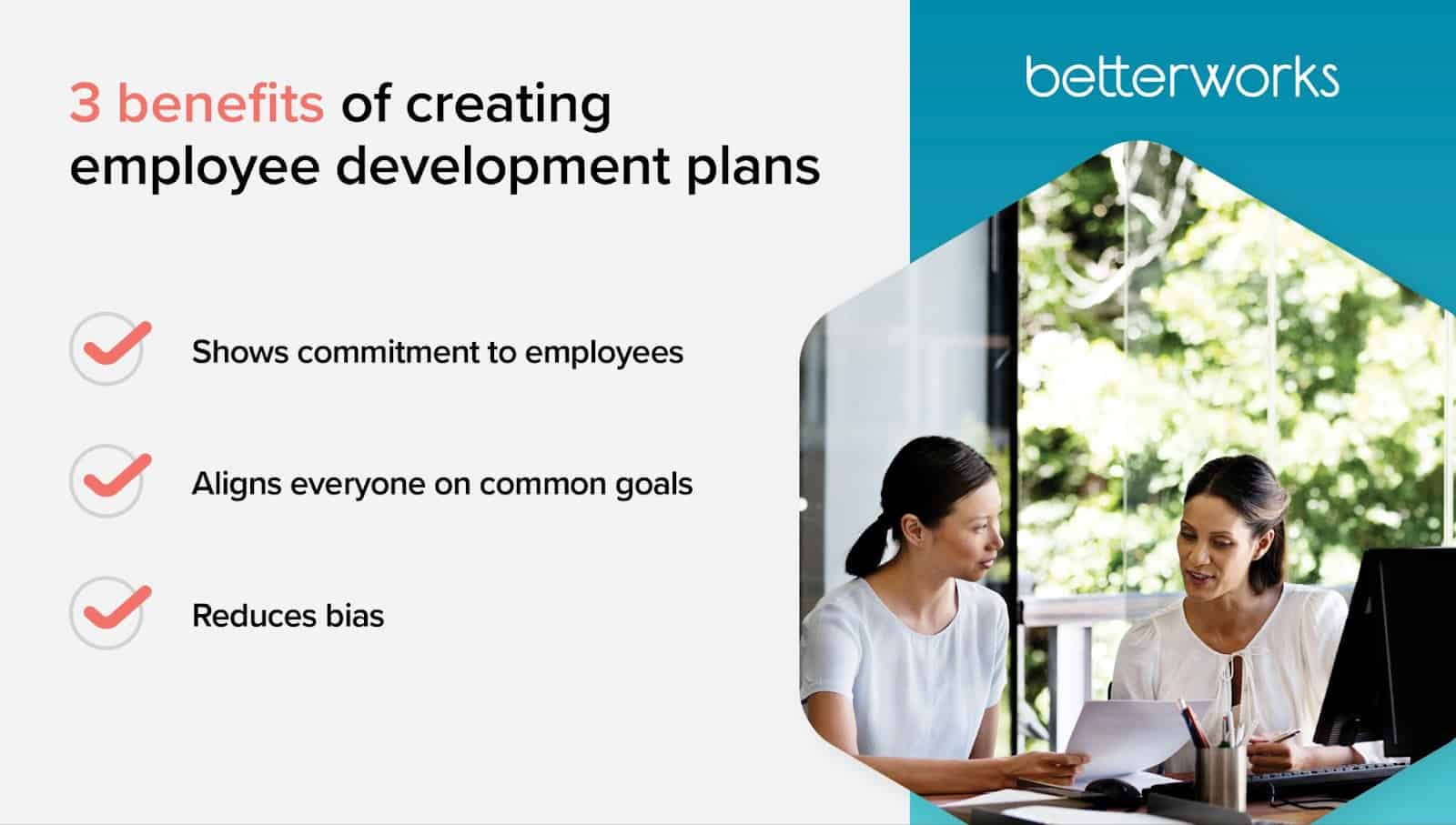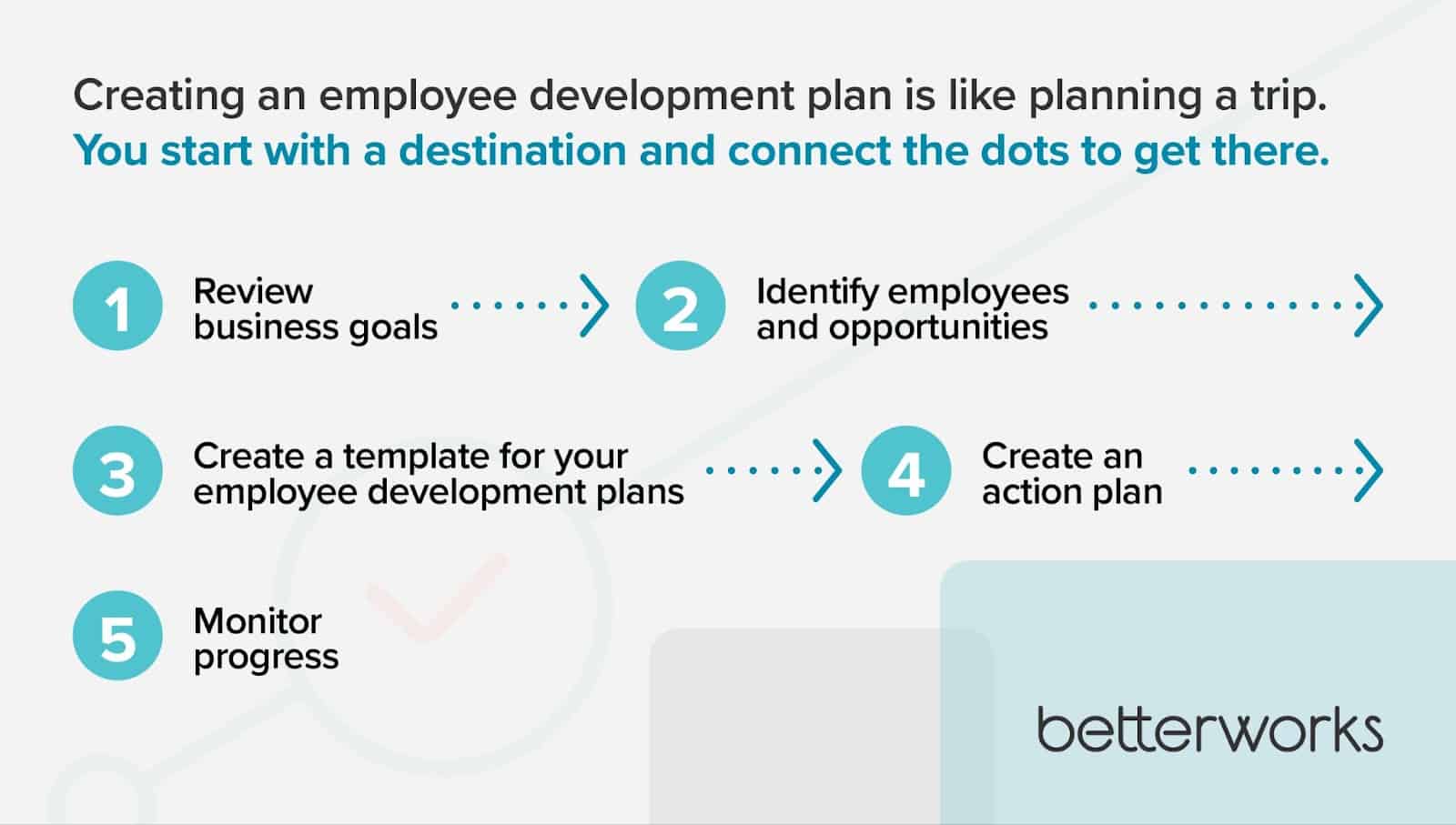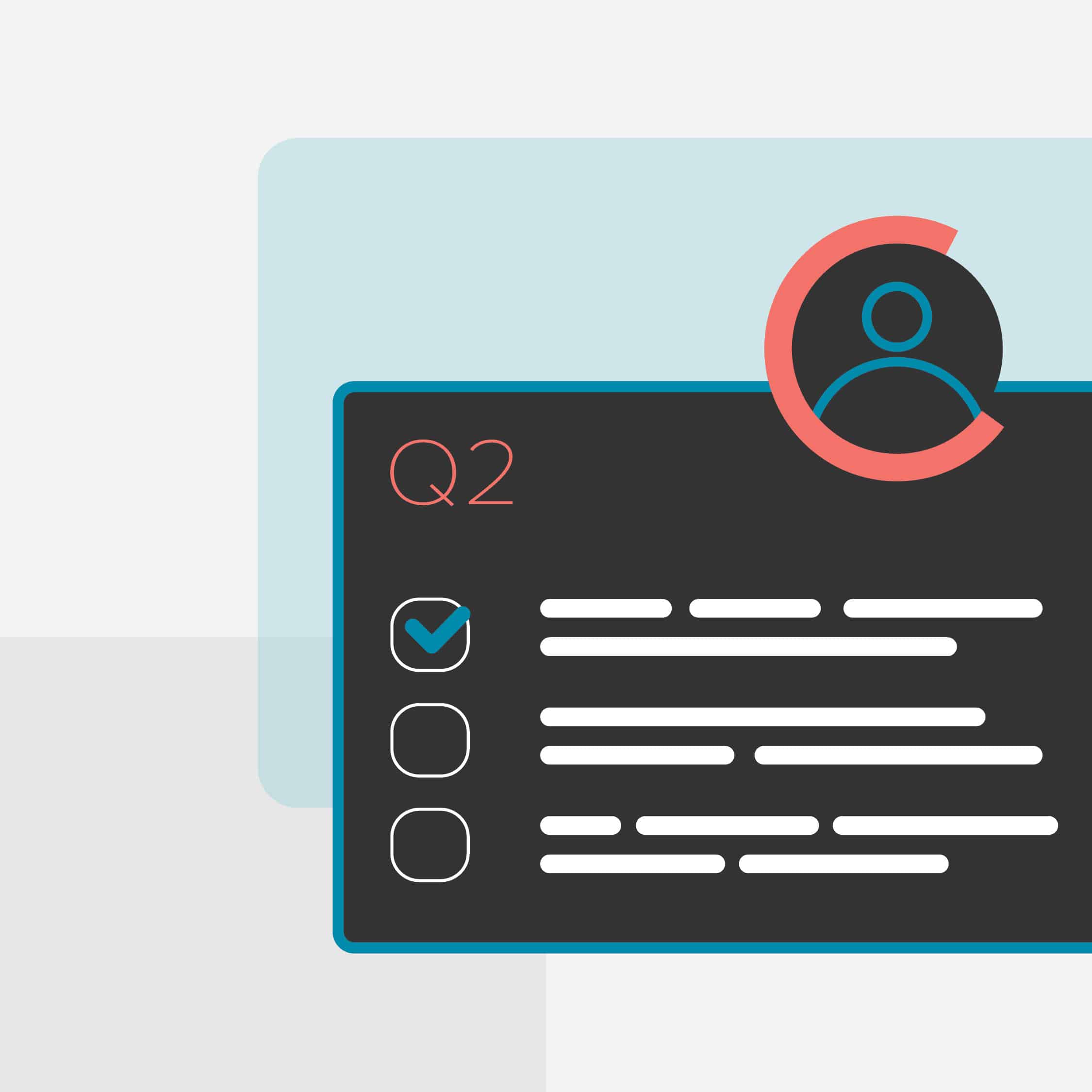Employee development can be the difference between a person staying or looking elsewhere, and great employee development plan examples can help you scale those efforts across your organization.
It’s worth the effort: A Pew Research Center study found that 63% of people quit their jobs in 2021 because there were no opportunities for advancement. When employees see how they can learn, grow, and advance in your organization, they’re more likely to stick around — and contribute even more value when they do.
Learn more about the importance of employee development plans, what they look like, and how to create these plans with your organization.
Why do employee development practices matter?
Employee development practices signal to workers that they have a future with your company and your investment in them. The role of learning and development should be visible and strategic, so employees see that investment and take advantage of the opportunities.
Employee development practices strongly influence employee satisfaction[d]. According to Gallup and Amazon’s 2021 American Upskilling Study, 71% of workers who completed upskilling said it positively affected job satisfaction. Employer involvement is crucial — satisfaction was more likely to increase when learning took place during work hours versus employer-sponsored training that was off-hours and unpaid.
By investing in employee professional development, you are honing employee strengths, increasing their knowledge base, and equipping them with skills that make them more resourceful and productive at work. That investment increases your workforce’s productivity and effectiveness, which supports overall business goals.
Employee development leads to greater job satisfaction

Why is creating an employee development plan important?
Hiring outside talent can be expensive and puts you in direct competition with other employers in the open job market. Upskilling and reskilling your current team members, in contrast, can help you retain talent, protect institutional knowledge, and strengthen your culture.
Employee development planning can generate a number of business benefits.
Shows commitment to employees
Investing in employee development plans across your organization demonstrates your commitment to your people in a tangible way.
Upskilling, professional development, and coaching are some ways companies can invest in employees. These investments signal to employees that they are valued and can continue to thrive within your organization.
By recognizing employee contributions and investing in people’s growth, you send a powerful message that your organization’s culture values learning and development. In return, your employees are more likely to remain loyal because they feel recognized, respected, and cared for.
Aligns everyone on common goals
Aligning employees with company goals is a key aspect of performance management. This alignment can be easier to achieve when employees feel that their professional growth is also part of those company goals.
Employee development plans reinforce this alignment by providing additional context and meaning for people’s daily work while showing them what’s next in their careers. Aligning L&D to job objectives can make training feel like a rewarding experience rather than an obligation.
When your team members understand how their current skills contribute to overall business outcomes and what they need to learn to achieve their next milestone, they will have clear goals to work toward, increasing engagement and productivity.
Reduces bias
Employee development plans can reduce bias in organizational decisions, such as promotions, by using standardized plans and objective analytics to identify existing skills gaps, create opportunities for growth, and measure progress.
Development plans reduce the likelihood that advancement opportunities are handed out based on manager favoritism, perceptions not based on data and outcomes, or other unfairly biased assumptions. Structured and standardized development strategies also help managers deliver consistent experiences to employees and stay aligned with company goals.
However, opportunities for implicit bias exist in all processes, so HR should regularly examine employee development systems for biases that unfairly favor some people or groups over others.

What types of employee development plans exist?
Employee development plans can differ depending on the organization’s goals, the employee’s career stage, and whether the development is aspirational (developing high-potential employees, for example) or corrective (performance improvement plans). Here are just three of the many types of development plans.
Professional development
A professional development plan is a comprehensive growth program designed for individual employees. Professional development plans combine the employee’s learning and career goals with personal goals that influence their ability to grow into their careers. Those goals might be achievable at their current workplace, but not always.
For example, suppose a hospital operations director wanted to teach health management at a local university. In that case, a professional development plan could explore how the hospital could support them in achieving that goal.
Career development
Career development plans are more targeted than professional development plans. They identify the skills and competencies employees need to achieve their career goals.
Career development plans have four primary components:
- Where the employee is now
- Where they want to go
- Where they can improve
- What the plan is for improvement
For example, if a junior account manager’s career goal is to lead their own team, a career development plan could lay out specific areas to improve or skills to achieve, along with actionable steps to bridge those gaps and proceed toward the goal.
Leadership development
Leaders can be developed from within or hired from the outside. External leadership hires can be valuable because they bring specific experiences and skills with them that your organization might otherwise be unable to acquire.
Internal leadership development programs allow your organization to invest in and train potential leaders who understand your culture, align with values, have strong relationships with co-workers, and are familiar with processes. These qualities can be found in outside candidates, but there’s more uncertainty with those hires.
Leadership and management training was the primary focus for nearly 50% of learning and development initiatives globally this year, according to LinkedIn’s 2022 Workforce Learning Report. Leadership development plans focus on preparing employees for advanced leadership and senior management roles within your company.
Companies that embrace leadership development improve their approach to succession planning while engaging high performers in structured leadership opportunities, mentorship, and networking. This type of development plan requires a firm commitment from the employee and leadership team.
For example, an insurance company claims manager is tapped to become the next director of claims for the company. A leadership development plan would include mentoring from the current director and training for the position’s additional responsibilities.
Who should create employee development plans?
HR might lead the rollout of employee development plans, but they’re generally not responsible for creating them. Managers and employees must take ownership of this vital work.
HR’s role includes identifying the skills needed for each job role and for the organization as a whole, as well as the gaps between the workforce’s existing skill set and what’s needed to close them. HR then communicates those learning priorities to managers. HR facilitates professional development opportunities with input from managers and executives. These opportunities can include in-person training, one-on-one or group coaching, online courses, mentorship, and on-the-job learning through internal gigs or projects.
Managers play an essential role in helping create employee development plans because they are closest to the situation and have ongoing conversations about performance, day-to-day work challenges, and career aspirations. During check-ins, managers can talk with employees about current skill sets, what’s missing, and what’s needed to achieve higher-level professional goals. Managers also go through this process with their bosses to further their professional development and become better leaders for their direct reports.
Individual employees, meanwhile, are the stars of their own development. To create a development plan, they must reflect on their interests, goals, and aspirations, both within the organization and outside of it. They must understand and express their short- and long-term goals. For the purposes of employee development plans, they’ll focus on what they would like to achieve within your organization.
How to create employee development plans
Creating an employee development plan is like planning a trip. You start with a destination and connect the dots to get there.
1 Review business goals
Start with the big-picture business goals as you create employee development plans. While the C-suite isn’t directly managing front-line employee development, the strategic goals they agree on will influence how all employees are developed.
Review your company’s business strategy and the plan for executing it. Identify the specific frameworks, actions, and tasks needed to achieve those goals. HR leaders can then ask questions such as:
- What skills are required to achieve those goals?
- Which of those skills does our workforce already possess?
- What skills need to be developed?
The HR team can organize the development and training processes and resources needed to bridge the gap between the skills your workforce possesses and the skills required to fulfill your organization’s goals.
2 Identify employees and opportunities
Based upon overall business objectives, the results of the skills analysis, and your organization’s structures for learning and development, the HR team can collaborate with managers to identify employees who would be the best fit for further development (and in what form).
HR’s analysis of employee performance data can be a great starting point for these conversations. Managers can use those insights and what they learn in daily work and regular employee check-ins to map out potential workforce development and skills opportunities with individual employees.
Employees at every career stage can benefit from professional development opportunities to improve their role-specific technical skills or transferable “soft” skills.
Not every professional development plan will focus on promotions. Many people don’t want to become managers or executives, after all. People also benefit from development opportunities that help them do their current jobs better or make lateral moves within the business.
3 Create a template for your employee development plans
While individual managers will do much of the work to develop employees, HR can ease that process and guarantee consistent results by providing an employee development template.
An employee development template offers a standardized framework for determining the type of development plan an employee needs, assessing their strengths and weaknesses, and confirming what direction an employee wants their careers to take.
Compiling all of the components of the employee development planning process into an accessible document or platform gives managers a consistent set of questions to kick off development conversations with employees. It also helps make sure those conversations are distilled into an actionable plan.
4 Establish an action plan
Next, managers can use these templates to create standardized action plans that account for each person’s strengths and weaknesses, current role, and career aspirations. They’ll work with employees to set and commit to goals, along with a timeline and plan of action for achieving those goals.
HR leaders are responsible for facilitating and organizing professional development opportunities for your organization. HR, talent, and learning and development professionals can vet and suggest learning content for employees, such as speakers, webinars, and conferences. HR may also be responsible for choosing the performance management or L&D platform used to track people’s progress.
Managers then give their team members the time and space to embrace their development plans, as well as opportunities to put what they’ve learned into practice. That may not necessarily involve formal classes.
For example, an employee who wants more leadership experience might be placed in charge of an ad hoc team working on a cross-functional project. This allows them to practice leadership skills in a real-life setting without the pressure they’d face if handed a full, permanent team.
5 Monitor progress
Connect employee development activities to the organizational, team, and individual goals, and create a system to track everyone’s progress transparently toward those objectives.
Connect employee development plans to tools that provide visibility for your HR team, managers, and employees themselves. Goal alignment software, for example, empowers employees to see how they’re progressing toward an objective and how that supports company goals, while managers can provide additional guidance if progress is insufficient or the development activities aren’t focused correctly.
Employee development plans might need to be revised as conditions change or the employees’ goals adapt, and that’s OK. To stay ahead of change, managers and employees can regularly reevaluate goals and development activities, potentially with the guidance of HR.
For example, an employee plans to become a certified associate in project management. However, they fall short of the 1,500 hours of project experience necessary to qualify for the next exam. The employee’s manager can help them schedule more hours to be eligible for a later exam.

Employee development plan examples
Employee development plans can take many forms. The following examples may help you visualize potential ways to use these processes at your company.
Pursuing a move to management
An entry-level sales development representative (SDR) wants to become a sales manager. As a new employee with relatively little experience, they will need to develop significant additional knowledge, skills, and experiences before they can achieve that goal. The employee works with their manager to assess where they are now, develop a professional development plan, and put the plan into action.
Moving laterally to new function
A project manager has been with the company for several years. They excel in their current role but feel they need a change. They’re interested in finance and customer success, but uncertain about which function would be the best fit. HR and the employee’s manager can help them identify opportunities for cross-functional projects that would expose them to other roles. Once a good match is found, they can create an action plan to add any missing skills to prepare the employee for a new role as soon as one opens up.
Developing a manager into an executive
A middle manager has been identified as a good candidate for executive leadership. They have excellent people management skills, but they haven’t had much experience yet formulating and communicating strategy at scale.
The manager’s boss and HR can help them make this move into senior management, learn new skills, and put them into practice. The desired outcome, in this case, could involve the new executive building out a strategic framework and coaching lower-level managers on executing it, but without micromanaging or undercutting those managers.
Improving performance
An employee has shown decreased productivity for the past quarter. Their manager meets with them one-on-one to discuss their performance. The employee and the manager work together to identify potential roadblocks and agree on what level of performance must be achieved. Based on the conversation, the manager puts together a performance improvement plan that includes steps the employee should take, what they’re expected to learn or achieve, and how success will be measured.
Invest in your most valuable resource
Employee development plan examples show you how to bring these processes to life at your company. But you’ll want to start by examining your organization’s overall strategic goals, performance review policies, and skills inventory.
From there, you can create frameworks and guidelines for how employee development will work at your organization. You’ll start to see what employee development opportunities are needed, how they’ll fit your values, and what managers need to know to execute these plans effectively, consistently, and fairly.
Your employees are your company’s most valuable resource. Applying the lessons from these employee development plan examples can help you demonstrate to employees that you’re committed to their professional growth and advancement — and that they can succeed right where they are.
Learn more about professional development in: Skills of the Future: Building Professional Development in a Flexible Workplace.







